I spent several hours last night and this morning looking over all the posts since we started if:book last december. It’s been a remarkably interesting experience working with my colleagues, exploring and defining the boundaries of our interests and effort. Here are a few posts i picked out for one reason or another. On monday we’ll post a new revised mission statement for the institute .
1. Three Books That Influenced Your Worldview: The List
we launched the site with the results of our first though experiment in which we asked people to name the three books that most influenced their world view. the results were very interesting. check out the exchange with Alan Kay too.
2. networked book/book as network
kim wrote this first if:book post which mentioned the concept of a “networked book” — a subject that we keep coming back to and find increasingly exciting.
3. genre-busting books
sol gaitan was our most frequent guest blogger. the breadth of her cultural knowledge and her constant reminder that the boundaries of our world extend beyond the hyper-connected coasts of the U.S. are a crucial and welcome contribution.
4. from the nouveau roman to the nouveau romance
one of a dozen or so long posts from Dan who took a seemingly obscure subject and wove it into a deliciously interesting discussion completely relevant to our effort to understand the shifting landscape of intellectual discourse. a more recent one
5. contagious media: symptom of what’s to come?
first time we experimented with making our work open and transparent. this idea grew over time and is now in the draft of our new mission statement which says, Academic institutes arose in the age of print, which informed the structure and rhythm of their work. The Institute for the Future of the Book was born in the digital era, and we seek to conduct our work in ways appropriate to the emerging modes of communication and rhythms of the networked world. Freed from the traditional print publishing cycles and hierarchies of authority, the Institute seeks to conduct its activities as much as possible in the open and in real time.
6. ted nelson & the ideologies of documents
a brilliant post by Dan about the importance of (much-maligned visionary) Ted Nelson’s views on the way we choose to structure and represent knowledge.
7. it seems to be happening before our eyes, Pt 1 and Pt2
2005 is likely to be remembered as the year that we started to pay more attention to individual voices in the blogosphere than the mainstream media. The NY Times and Washington Post may never recover from the exposures that showed they were in cahoots with the Bush administration over Plamegate and the admission of wholesale unauthorized wire-tapping.
8. blog reading: what’s left behind
dan wrote this post about the deficiencies of the structure of blogs. it’s a recurring theme at the institute and you’ll see a lot more about it in the coming year.
9. transliteracies: research in the technological, social, & cultural practices of online reading
ben re-posted this interesting discussion by Alan Liu on the changing nature of reading and browsing in an online context.
10. flushing the net down the tubes
ben’s first post on the crucial subject of the coming battle in which the telcos and cable companies will try to turn the web into a broadcast medium favoring the big media companies over individual voices.
11. sober thoughts on google: privatization and privacy
thanks to ben’s thougtful posts, the institute has gained a reputation for developing an even-handed view of Google book scanning and searching project.
12. the “talk to me” crew talks with the institute
now that we’ve got our cool new offices in williamsburg (brooklyn), we’ve been inviting an interesting group of folks to lunch. Liz and Bill were two of our favorite visitors, written up in a nice post by Ray. Other interesting visitors were Ken Wark, Tom De Zengotita and Mitchelll Stephens.
13. the future of the book: korea, 13th century
couldn’t resist including ben’s write-up to a buddhist monastery in korea — both because it has the most beautiful photo that appeared in the blog and for one of my favorite images . . . the whole monastery a kind of computer, the monks running routines to and from the database.
Monthly Archives: December 2005
Wikipedia to consider advertising
The London Times just published an interview with Wikipedia founder Jimmy Wales in which he entertains the 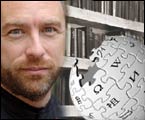 idea of carrying ads. This mention is likely to generate an avalanche of discussion about the commercialization of open-source resources. While i would love to see Wikipedia stay out of the commercial realm, it’s just not likely. Yahoo, Google and other big companies are going to commercialize Wikipedia anyway so taking ads is likely to end up a no-brainer. As i mentioned in my comment on Lisa’s earlier post, this is going to happen as long as the overall context is defined by capitalist relations. Presuming that the web can be developed in a cooperative, non-capitalist way without fierce competition and push-back from the corporations who control the web’s infrastructure seems naive to me.
idea of carrying ads. This mention is likely to generate an avalanche of discussion about the commercialization of open-source resources. While i would love to see Wikipedia stay out of the commercial realm, it’s just not likely. Yahoo, Google and other big companies are going to commercialize Wikipedia anyway so taking ads is likely to end up a no-brainer. As i mentioned in my comment on Lisa’s earlier post, this is going to happen as long as the overall context is defined by capitalist relations. Presuming that the web can be developed in a cooperative, non-capitalist way without fierce competition and push-back from the corporations who control the web’s infrastructure seems naive to me.
defending the creative commons license
interesting question came up today in the office. there’s a site, surferdiary.com, that reposts every entry on if:book. they do the same for several other sites, presumably as a way to generate traffic to their site and ultimately to gather clicks on their google supplied ads. if:book entries are posted with a creative commons license which allows reuse with proper attribution but forbids commercial use. surferdiary’s use seems to be thoroughly commercial. some of my colleagues think we should go after them as a way of defending the creative commons concept. would love to know what people think?
remix: the movie
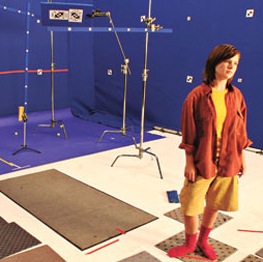 Wired magazine reports that Michela Ledwidge is advancing the future of filmmaking, by taking cues from game moding. In early 2006, she will post all the raw material for her 10 minute sci-fi short film, Sanctuary, to the website:www.modfilms.com . People will be able to edit their own versions of the film. Sanctuary continues the open source trend also fostered by recording artists such as Jay Z who released vocal files of his Black album to encourage DJs to create their own mixes. Some die-hard Jay Z fans even posted everything you need in a similar fashion to Ledwidge.
Wired magazine reports that Michela Ledwidge is advancing the future of filmmaking, by taking cues from game moding. In early 2006, she will post all the raw material for her 10 minute sci-fi short film, Sanctuary, to the website:www.modfilms.com . People will be able to edit their own versions of the film. Sanctuary continues the open source trend also fostered by recording artists such as Jay Z who released vocal files of his Black album to encourage DJs to create their own mixes. Some die-hard Jay Z fans even posted everything you need in a similar fashion to Ledwidge.
I hope that many people submit films. I am very interested to see what the results will be on the aggregate level. While many people will undoubtedly create mashup versions with external content, I am especially curious to see the results from people who do not add much additional material. How many interesting stories can be told using these basic parts? Is there a “correct” shot selection or a traditional (i.e. “I learned to edit in film school”) edit? How wedded are we to traditional film narrative conventions which dictate what is “good” and “bad”? Will only a few compelling narratives arise or will many?
why google and yahoo love wikipedia
 From Dan Cohen’s excellent Digital Humanities Blog comes a discussion of the Wikipedia story that Cohen claims no one seems to be writing about — namely, the question of why Google and Yahoo give so much free server space and bandwith to Wikipedia. Cohen points out that there’s more going on here than just the open source ethos of these tech companies: in fact, the two companies are becoming increasingly dependent on Wikipedia as a resource, both as something to repackage for commercial use (in sites such as Answers.com), and as a major component in the programming of search algorithms. Cohen writes:
From Dan Cohen’s excellent Digital Humanities Blog comes a discussion of the Wikipedia story that Cohen claims no one seems to be writing about — namely, the question of why Google and Yahoo give so much free server space and bandwith to Wikipedia. Cohen points out that there’s more going on here than just the open source ethos of these tech companies: in fact, the two companies are becoming increasingly dependent on Wikipedia as a resource, both as something to repackage for commercial use (in sites such as Answers.com), and as a major component in the programming of search algorithms. Cohen writes:
Let me provide a brief example that I hope will show the value of having such a free resource when you are trying to scan, sort, and mine enormous corpora of text. Let’s say you have a billion unstructured, untagged, unsorted documents related to the American presidency in the last twenty years. How would you differentiate between documents that were about George H. W. Bush (Sr.) and George W. Bush (Jr.)? This is a tough information retrieval problem because both presidents are often referred to as just “George Bush” or “Bush.” Using data-mining algorithms such as Yahoo’s remarkable Term Extraction service, you could pull out of the Wikipedia entries for the two Bushes the most common words and phrases that were likely to show up in documents about each (e.g., “Berlin Wall” and “Barbara” vs. “September 11” and “Laura”). You would still run into some disambiguation problems (“Saddam Hussein,” “Iraq,” “Dick Cheney” would show up a lot for both), but this method is actually quite a powerful start to document categorization.
Cohen’s observation is a valuable reminder that all of the discussion of Wikipedia’s accuracy and usefulness as an academic tool is really only skimming the surface of how and why the open-souce encyclopedia is reshaping the way knowledge is made and accessed. Ultimately, the question of whether or not Wikipedia should be used in the classroom might be less important than whether — or how — it is used in the boardroom, by companies whose function is to repackage, reorganize and return “the people’s knowledge” back to the people at a tidy profit.
another view on the stacey/gamma flap
For an alternative view of Lisa’s earlier post … i wonder if Gamma’s submission of Adam Stacey’s image with the “Adam Stacey/Gamma” attribution doesn’t show the strength of the Creative Commons concept. As i see it, Stacey published his image without any restrictions beyond attribution. Gamma, a well-respected photo agency started distributing the image attributed to Stacey. Isn’t this exactly what the CC license was supposed to enable — the free-flow of information on the net. perhaps Stacey chose the wrong license and he didn’t mean for his work to be distributed by a for-profit company. If so, that is a reminder to all of us to be careful about which Creative Commons license we choose. One thing i’m not clear on is whether Gamma referenced the CC license. They are supposed to do that and if they didn’t they should have.
phone photo of london underground nominated for time best photo; photo agency claims credit for creative commons work
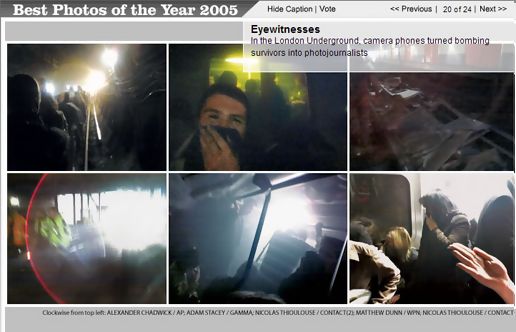
Moblog co-founder Alfie Dennen is furious that the photo agency Gamma has claimed credit for a well-known photo of last summer’s London subway bombing –first circulated on Moblog under a Creative Commons liscence — that was chosen for Time’s annual Best Photo contest. Dennen and others in the blogosphere are hoping that photographer Adam Stacey might take legal action against Gamma for what seems to be a breach of copyright.
We at the Institute are still trying to figure out what to make of this. Like everyone else who has been observing the increasing popularity of the Creative Commons license, we’ve been wondering when and how the license will be tested in court. However, this might not be the best possible test case. On one hand, it seems to be a somewhat imperious “claiming” of a photo widely celebrated for being produced by a citizen journalist who was committed to its free circulation. One the other hand, it seems unclear whether Dennen and/or Stacey are correct in their assertion that the CC license that was used really prohibits Gamma from attaching their name to the photo.
The photo in question, a shot of gasping passengers evacuating the London Underground in the moments after last summer’s bombing (in the image above, it’s the second photo clockwise), was snapped by Stacey using the camera on his cellphone. Time’s nomination of the photo most likely reflects the fact that the photo itself — and Stacey — became something of a media phenomenon in the weeks following the bombing. The image was posted on Moblog about 15 minutes after the bombing, and then widely circulated in both print and online media venues. Stacey subsequently appeared on NPR’s All Things Considered, and the photo was heralded as a signpost that citizen journalism had come into its own.
While writing about the photo’s appearance in Time, Dennen noticed that Time had credited the photo to Adam Stacey/Gamma instead of Adam Stacey/Creative Commons. According to Dennen, Stacey had been contacted by Gamma and had turned down their offer to distribute the photo, so the attribution came as an unpleasant shock. He claims that the license chosen by Stacey clearly indicates that the photo be given Creative Commons attribution. But is this really clear? The photo is attributed to Stacey, but not to Creative Commons: does this create a grey area? The license does allow commercial use of Stacey’s photo, so if Gamma was making a profit off the image, that would be legal as well.
Dennen writes on his weblog that he contacted Gamma for an explanation, arguing that after Stacey told the agency that he wanted to distribute the photo through Creative Commons, they should have understood that they could use it, but not claim it as their own. Gamma responded in an email that, “[we] had access to this pix on the web as well as anyone, therefore we downloaded it and released it under Gamma credit as all agencies did or could have done since there was no special requirement regarding the credit.” They also claimed that in their conversation with Stacey, Creative Commons never came up, and that a “more complete answer” to the reason for the attribution would be available after January 3rd, when the agent who spoke with Stacey returned from Christmas vacation.
Until then, it’s difficult to say whether Gamma’s claim of credit for the photo is accidental or deliberate disregard. Dennen also says that he’s contacting Time to urge them to issue a correction, but he hasn’t gotten a response yet. I’ll follow this story as it develops.
mothlight
i. the text of light
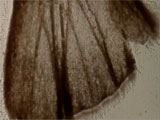 The filmmaker Stan Brakhage is one of those people whose work hangs in the back of my mind with a frequency well out of proportion to my actually engaging with his work. I first (and really, only, until recently) saw his films about seven years ago, when he introduced a marathon screening of what must have been almost his complete works. Hours later, I stumbled out of the theatre, knowing that this was someone whose work I should have seen years before, having seen on the screen something new to me, a new way of looking at the possibility of film. I’ve felt an analogous sensation with only a handful of artists and writers; I’ve found it again in the luminously fractured English of Amos Tutuola, Ray Johnson’s conceptual games of “correspondance”, and Michel Butor’s reimagining of the page and narrative.
The filmmaker Stan Brakhage is one of those people whose work hangs in the back of my mind with a frequency well out of proportion to my actually engaging with his work. I first (and really, only, until recently) saw his films about seven years ago, when he introduced a marathon screening of what must have been almost his complete works. Hours later, I stumbled out of the theatre, knowing that this was someone whose work I should have seen years before, having seen on the screen something new to me, a new way of looking at the possibility of film. I’ve felt an analogous sensation with only a handful of artists and writers; I’ve found it again in the luminously fractured English of Amos Tutuola, Ray Johnson’s conceptual games of “correspondance”, and Michel Butor’s reimagining of the page and narrative.
 But Brakhage. His films tend to be short and silent. His editing, if it can be called such, is quick – often an image only shows for a frame, then it’s gone. In most of his films, he cuts quickly between shots; in some of his work he abandoned the camera entirely to work directly with the film stock itself, painting on it or gluing things to it. Jean-Luc Godard said that the cinema was the truth twenty-four times a second; rarely has this been so literally explicated as in Brakhage’s films. Mitchell Stephens, in The Rise of the Image, the Fall of the Word saw in the lighting-fast editing style that Brakhage introduced a possible future for communication. But Brakhage was following his own very particular muse. His aim, he declared in one of his later films, was to show on film what the eye sees when it is closed, the phenomenon of dancing spots of color that’s been termed hypnogogic vision.
But Brakhage. His films tend to be short and silent. His editing, if it can be called such, is quick – often an image only shows for a frame, then it’s gone. In most of his films, he cuts quickly between shots; in some of his work he abandoned the camera entirely to work directly with the film stock itself, painting on it or gluing things to it. Jean-Luc Godard said that the cinema was the truth twenty-four times a second; rarely has this been so literally explicated as in Brakhage’s films. Mitchell Stephens, in The Rise of the Image, the Fall of the Word saw in the lighting-fast editing style that Brakhage introduced a possible future for communication. But Brakhage was following his own very particular muse. His aim, he declared in one of his later films, was to show on film what the eye sees when it is closed, the phenomenon of dancing spots of color that’s been termed hypnogogic vision.
 Mothlight, stills from which can be seen floating about this post, was one of the films that stuck most clearly in my mind. In it, Brakhage set out to show “what a moth might see from birth to death if black were white and white were black.” The ratio of the size of the moth to that of ourselves is roughly that of the size of a film negative to the blown up film; with this in mind, and a collection of dead moths that had flown into a light and perished, Brakhage composed a three-minute film, every frame of which is composed of things from the moth’s world: wings, plant leaves, and flowers. Brakhage pasted these objects directly onto the film stock. When the film is projected there’s a rush of images made unfamiliar by size: a moth wing or a flower twenty feet wide is something we’ve never seen before. Though constructed of objects that we imagine we know, the moth’s world as Brakhage depicts it is utterly foreign to us. Speed has a lot to do with it: the eye can’t possibly process twenty-four different images per second. The moth’s world is much faster than our own.
Mothlight, stills from which can be seen floating about this post, was one of the films that stuck most clearly in my mind. In it, Brakhage set out to show “what a moth might see from birth to death if black were white and white were black.” The ratio of the size of the moth to that of ourselves is roughly that of the size of a film negative to the blown up film; with this in mind, and a collection of dead moths that had flown into a light and perished, Brakhage composed a three-minute film, every frame of which is composed of things from the moth’s world: wings, plant leaves, and flowers. Brakhage pasted these objects directly onto the film stock. When the film is projected there’s a rush of images made unfamiliar by size: a moth wing or a flower twenty feet wide is something we’ve never seen before. Though constructed of objects that we imagine we know, the moth’s world as Brakhage depicts it is utterly foreign to us. Speed has a lot to do with it: the eye can’t possibly process twenty-four different images per second. The moth’s world is much faster than our own.
The memory of that flicker of images has stayed with me, as much for its ephemerality as anything else: I’d seen something briefly, not long enough to remember the images themselves, but long enough to remember the film more clearly than nearly anything else I saw that year.
ii. the act of seeing with one’s own eyes
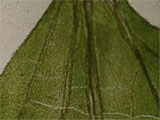 The Criterion Collection released a two-DVD set of some of Brakhage’s films a few years ago, a year or so before he passed away and was briefly in the news again. I’m not sure why I held off buying a copy of the DVD: maybe a devotion to the ephemerality of memory? I did convince an old roommate, a painter, to buy his own copy soon after it was released: independently, he had been trying to capture with oils hypnogogic visions of his own. But I didn’t get a copy until a few weeks ago, when after finding him again in Mitchell Stephens’s book, I broke down for an online Christmas DVD sale. It arrived, and I inserted one of the discs into my Powerbook, curious to see how his films compared to my memory of them.
The Criterion Collection released a two-DVD set of some of Brakhage’s films a few years ago, a year or so before he passed away and was briefly in the news again. I’m not sure why I held off buying a copy of the DVD: maybe a devotion to the ephemerality of memory? I did convince an old roommate, a painter, to buy his own copy soon after it was released: independently, he had been trying to capture with oils hypnogogic visions of his own. But I didn’t get a copy until a few weeks ago, when after finding him again in Mitchell Stephens’s book, I broke down for an online Christmas DVD sale. It arrived, and I inserted one of the discs into my Powerbook, curious to see how his films compared to my memory of them.
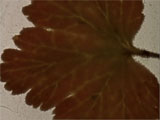 Watching him the first time, I’d been supine before the screen. Watching him on my laptop was something different, something surprising. My first impulse after starting one of the films playing was the obvious one when something’s going too fast, but not an option that one has when you’re part of an audience: to hit the pause button. The moth wings, spider webs, flowers, and blades of grass instantly snap into startling focus: around every object, you can see the halo of glue that Brakhage used to hold it to the celluloid. Then another pleasant surprise: on the Apple DVD player, if you then press the right arrow button, you can advance one frame. Not another frame in the same shot, as one would expect in an ordinary film, but another image entirely, though sometimes, you realize, a connected object: in some frames one sees the top of a plant leaf, in the following, the bottom, exactly as Brakhage constructed the film. (Images of the film stock itself – not just screencaptures from the DVD – can be seen at critic Fred Camper’s website, which offers a dizzying amount of information on Stan Brakhage.)
Watching him the first time, I’d been supine before the screen. Watching him on my laptop was something different, something surprising. My first impulse after starting one of the films playing was the obvious one when something’s going too fast, but not an option that one has when you’re part of an audience: to hit the pause button. The moth wings, spider webs, flowers, and blades of grass instantly snap into startling focus: around every object, you can see the halo of glue that Brakhage used to hold it to the celluloid. Then another pleasant surprise: on the Apple DVD player, if you then press the right arrow button, you can advance one frame. Not another frame in the same shot, as one would expect in an ordinary film, but another image entirely, though sometimes, you realize, a connected object: in some frames one sees the top of a plant leaf, in the following, the bottom, exactly as Brakhage constructed the film. (Images of the film stock itself – not just screencaptures from the DVD – can be seen at critic Fred Camper’s website, which offers a dizzying amount of information on Stan Brakhage.)
Technically, this is not very exciting at all: pausing to see a crisp frame is just one of the niceties of the DVD that we’re all used to. But what this does to the viewer’s experience of the film is immeasurable. Instead of the imposed stricture of watching the images projected at 24 frames per second, you’re free to proceed through Brakhage’s frames at any rate you like – his film becomes something like a slide show. As great a change, though, is imparted to the viewer, who goes from being a passive recipient of speeding images to an active participant with control over what’s being shown.
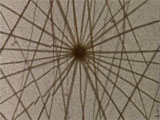 This isn’t, it’s worth pausing to consider, something that would have been possible with a VHS tape. Video didn’t respect the frames of film, and a paused VHS tape generally gives you a blurred and indistinct image. Presumably with a projector and a copy of the original films, you could do the same thing. (This would also resolve the incongruity of looking at images that are meant to have light projected through them rather than being composed of red, green, and blue blips of it, as on my computer screen.) Alas, not many of us have our own movie theater to try this out in. For the rest of us, this amount of control is something that arrives with new digital media, and deserves to be considered as a function of it.
This isn’t, it’s worth pausing to consider, something that would have been possible with a VHS tape. Video didn’t respect the frames of film, and a paused VHS tape generally gives you a blurred and indistinct image. Presumably with a projector and a copy of the original films, you could do the same thing. (This would also resolve the incongruity of looking at images that are meant to have light projected through them rather than being composed of red, green, and blue blips of it, as on my computer screen.) Alas, not many of us have our own movie theater to try this out in. For the rest of us, this amount of control is something that arrives with new digital media, and deserves to be considered as a function of it.
From time to time, Bob talks to the programmers busy making Sophie about imagining film as being a book that’s flipping through 86,400 pages per hour. This sort of talk tends to throw them into conniptions (to paraphrase: nobody in their right mind thinks that way & how current processors don’t have nearly enough computational power and they probably won’t for the next fifty years). But despite their objections, that’s almost exactly what we have here, if not through design. It’s worth noting, of course, that the tools for reading film in this way aren’t yet perfect: while I can press the right arrow to advance a frame in my DVD player, I can’t, for some reason, press the left arrow to go back a frame: you have to rewind. I can’t look at several consecutive frames together without a fair amount of work. There’s more work for the programmers.
iii. mothlight
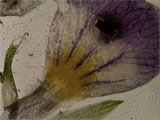 Thinking about technology for the past month or so, I’ve often found myself in a mild funk, which might be the sort of thing one expects to set in around the end of the year, when I, at least, find myself wanting to neatly box the disjointed events of the past year to take up to the attic for storage. The crux of my worrying: while there’s clearly no shortage for ideas of new ways to say things – as even a cursory reading of this blog will readily attest – there seems to be a comparative paucity of new ways to understand things. Maybe this makes sense: people like novelty. It’s more exciting to announce something brand new and different than to find a new way to look at something familiar. Who can be bothered to care about a fourteenth way of looking at a blackbird when you can make your own genetically-modified fuchsia- and chartreuse-birds?
Thinking about technology for the past month or so, I’ve often found myself in a mild funk, which might be the sort of thing one expects to set in around the end of the year, when I, at least, find myself wanting to neatly box the disjointed events of the past year to take up to the attic for storage. The crux of my worrying: while there’s clearly no shortage for ideas of new ways to say things – as even a cursory reading of this blog will readily attest – there seems to be a comparative paucity of new ways to understand things. Maybe this makes sense: people like novelty. It’s more exciting to announce something brand new and different than to find a new way to look at something familiar. Who can be bothered to care about a fourteenth way of looking at a blackbird when you can make your own genetically-modified fuchsia- and chartreuse-birds?
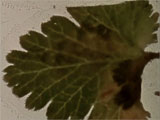 My funk wasn’t straight misoneism: I’m all for new forms else I wouldn’t be working here. But if we’re to create new forms that resonate as strongly as the physical book has been able to historically – a project that I suspect Brakhage considered himself engaged in – it’s just as important to find new ways to understand how what we’ve created works. And this is I think why the simple gesture of hitting the “pause” button in the middle of a film feels like something of a revelation to me, puncturing my December miasma. It’s not a blinding Damascene conversion, and that’s perhaps the point: it’s a realization that there are plenty of possibilities for new ways to look at things. We just need to notice them.
My funk wasn’t straight misoneism: I’m all for new forms else I wouldn’t be working here. But if we’re to create new forms that resonate as strongly as the physical book has been able to historically – a project that I suspect Brakhage considered himself engaged in – it’s just as important to find new ways to understand how what we’ve created works. And this is I think why the simple gesture of hitting the “pause” button in the middle of a film feels like something of a revelation to me, puncturing my December miasma. It’s not a blinding Damascene conversion, and that’s perhaps the point: it’s a realization that there are plenty of possibilities for new ways to look at things. We just need to notice them.
The late Guy Davenport, one of Brakhage’s friends and a kindred spirit, defended the unity of some of his own work – short stories that included his own drawings as an integral part of the story – by arguing that text, picture, and film weren’t in opposition, but were all images alike:
“A page, which I think of as a picture, is essentially a texture of images. . . . The text of a story is therefore a continuous graph, kin to the imagist poem, to a collage (Ernst, Willi Baumeister, El Lissitzky), a page of Pound, a Brakhage film.”
(from “Ernst Machs Max Ernst”, pp. 374-5 in The Geography of the Imagination)
 Davenport’s declaration can be turned inside-out: we can now take a Brakhage film and read it as a series of pages. The word and the image still aren’t quite the same thing, but digital media allows us to think about them in some of the same ways. Watching with the pause button ready, we can scrutinize the composition of a single frame of film just as you might scrutinize an individual line or words in a poem, a page of a book.
Davenport’s declaration can be turned inside-out: we can now take a Brakhage film and read it as a series of pages. The word and the image still aren’t quite the same thing, but digital media allows us to think about them in some of the same ways. Watching with the pause button ready, we can scrutinize the composition of a single frame of film just as you might scrutinize an individual line or words in a poem, a page of a book.
Or again: historically, the coming of the book might be seen as freeing the reader from the dominion of time. The pre-literate can only listen to a text being read, while the literate is free to read at leisure. It’s a pause button, of a sort. Brakhage’s moth seems an apt tool for thinking here. I haven’t done the math, but I’d imagine the ratio of the length of a moth’s life to our own is about the same as the ratio of the moth’s size to our own. When we look at a moth, we see a being utterly bound by time. But it doesn’t have to be that way.
bookcrossing.com and the future of the book
 I came across an an interesting overview piece on the future of the book in Global Politician, an online magazine that largely focuses on reporting underreported global issue stories. The author of the piece, economist and political consultant Sam Vaknin, covers much of the terrain we usually cover here at the Institute, but he also make an interesting point about how the online book-swapping collective Bookcrossing has been turning paper books into “networked books” over the past four years. Vaknin writes:
I came across an an interesting overview piece on the future of the book in Global Politician, an online magazine that largely focuses on reporting underreported global issue stories. The author of the piece, economist and political consultant Sam Vaknin, covers much of the terrain we usually cover here at the Institute, but he also make an interesting point about how the online book-swapping collective Bookcrossing has been turning paper books into “networked books” over the past four years. Vaknin writes:
Members of the BookCrossing.com community register their books in a central database, obtain a BCID (BookCrossing ID Number) and then give the book to someone, or simply leave it lying around to be found. The volume’s successive owners provide BookCrossing with their coordinates. This innocuous model subverts the legal concept of ownership and transforms the book from a passive, inert object into a catalyst of human interactions. In other words, it returns the book to its origins: a dialog-provoking time capsule.
I appreciate the fact that Vaknin draws attention to the ways in which books can be conceptually transformed by ventures such as BookCrossing even while they remain physically unchanged. Currently, there are only about half a million BookCrossing members, making the phenemenon somewhat less popular than podcasting, but given that most BookCrossing members are serious readers — and highly international — the movement is still noteworthy.
the future of the book: korea, 13th century
The database:
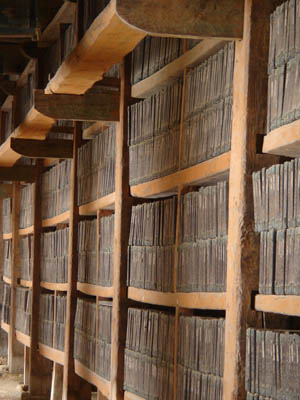

Nestled in the Gaya mountain range in southern Korea, the Haeinsa monastery houses the Tripitaka Koreana, the largest, most complete set of Buddhist scriptures in existence — over 80,000 wooden tablets (enough to print all of Buddhism’s sacred texts) kept in open-air storage for the past six centuries. The tablets were carved between 1237 and 1251 in anticipation of the impending Mongol invasion, both as a spiritual effort to ward off the attack, and as an insurance policy. They replaced an earlier set of blocks that had been destroyed in the last Mongol incursion in 1231.

From Korea’s national heritage site description of the tablets:
The printing blocks are some 70cm wide 24cm long and 2.8cm thick on the average. Each block has 23 lines of text, each with 14 characters, on each side. Each block thus has a total of 644 characters on both sides. Some 30 men carved the total 52,382,960 characters in the clean and simple style of Song Chinese master calligrapher Ou-yang Hsun, which was widely favored by the aristocratic elites of Goryeo. The carvers worked with incredible dedication and precision without making a single error. They are said to have knelt down and bowed after carving each character. The script is so uniform from beginning to end that the woodblocks look like the work of one person.
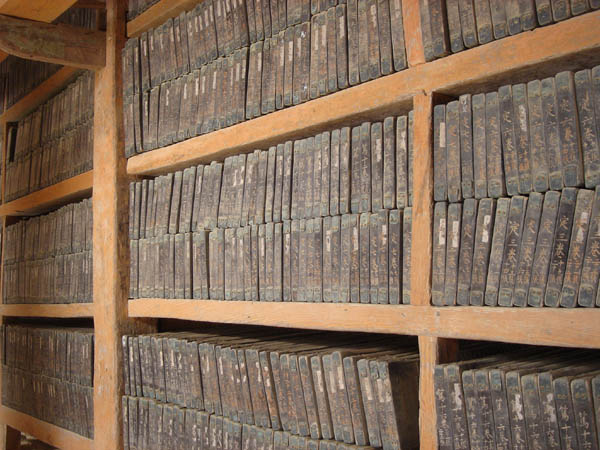

I stayed at the Haeinsa temple last Friday night on a sleeping mat in bare room with a heated floor, alongside a number of noisy Koreans (including the rather sardonic temple webmaster — Haiensa is a Unesco World Heritage site and so keeps a high profile). At three in the morning, at the call to the day’s first service, I tramped around the snowy courtyards under crisp, chill stars and watched as the monks pounded a massive barrel-shaped drum hanging inside a pagoda. This was for the benefit of those praying inside the temple (where it sounds like distant thunder). Shivering to the side, I continued to watch as they rang a bell the size of a Volkswagen with a polished log swung on ropes like a wrecking ball. Next to it, another monk ripped out a loud, clattering drum roll inside the wooden ribs of a dragon-like fish, also suspended from the pagoda’s roof. It was freezing cold with a biting wind — not pleasant to be outside, and at such an hour. But the stars were absolutely vivid. I’m no good at picking out constellations, but Orion was poised unmistakeably above the mountains as though stalking an elk on the other side of the ridge.
It’s a magical, somewhat harsh place, Haiensa. The Changgyeonggak, the two storage halls that house the Tripitaka, were built ingeniously to preserve the tablets by blocking wind, facilitating ventilation and distributing moisture. You see the monks busying themselves with devotions and chores, practicing an ancient way of life founded upon those tablets. The whole monastery a kind of computer, the monks running routines to and from the database. The mountains, Orion, the drum all part of the program. It seemed almost more hi-tech than cutting edge Seoul.
More on that later.
